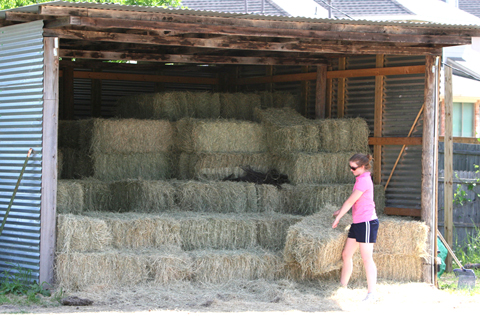
From the University of Nevada Cooperative Extension August 11 2009:
As bales of hay roll in from the fields on the back of farmers’ wagons, it’s again time to start staking your claim so that your hayloft remains full over the coming winter months. Here are some tips to help you select hay for your horses.
1. Remember that quality forage should be the backbone of your horse’s diet (a minimum of 2/3 of their nutrition).
2. Have a good working relationship with a hay supplier to ensure a consistent and reliable source of hay.
3. Consider adding hay storage space to reduce the effects of price and seasonal fluctuations (i.e. hay is sometimes more expensive in the winter versus the summer.
4. Buy hay early. Do not wait until late summer or fall to buy hay.
5. Plan in advance. Budget for any price increase and re-evaluate how many horses you can afford to feed.
6. Try to keep your hay type (i.e., grass or alfalfa) consistent. Constantly changing hay types can lead to horse health problems, specifically colic.
Finally, have hay analyzed so you know what you’re getting. What do hay analysis numbers mean, and how do they relate to your horse’s health?
Horse hay should be 10-17% moisture and about 10% crude protein. Crude protein is not likely to be a limiting part of the diet except in lactating mares, foals, or performance horses, which would require higher levels.
Hay with an acid detergent fiber (ADF) value of 30-35% is good for horses. The lower the ADF value, the more digestible the nutrients in the hay are. Hay at 45% or more ADF is of little nutritional value. Neutral detergent fiber (NDF) levels should be 40-50%, and most horses won’t eat anything above 65%.
Equine feed analyses also provide non-fiber carbohydrate (NFC) estimates to help select feed for horses that show sensitivity to starches and sugars and measure digestible energy (DE) in the hay. For a light working horse, DE should be about 20 Mcal/day, and most hays range from 0.76 to 0.94 Mcal/lb of DE. Calcium and phosphorus ratios can vary among different types of hay, an adult horse in a maintenance phase should have a calcium-to-phosphorus ratio of 3:1 to 1:1.
One resource for purchasing hay or determining the going price of hay and straw in your area is hayexchange.com.–Krishona Martinson, PhD, Equine Extension Specialist University of Minnesota.
